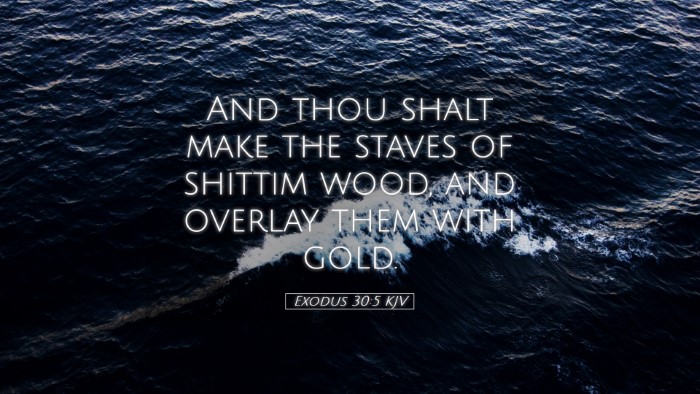Commentary on Exodus 30:5
Text of Exodus 30:5: "And you shall make the poles of acacia wood, and overlay them with gold."
Introduction
Exodus 30:5 is part of the instructions given to Moses for the construction of the Tabernacle, specifically concerning the altar of incense. This verse highlights the necessity for both functionality and beauty in sacred objects, emphasizing the holiness of the space where worship occurs. The poles (or staves) serve a practical purpose, allowing for easy transport of the altar, yet they are also presented with a covering of gold, symbolizing the divine nature of God's dwelling among His people.
Contextual Analysis
This verse sits within a broader narrative concerning the establishment of the Tabernacle as a place of worship. Each instruction given to Moses is deliberate, showcasing God's desire for a dwelling place among the Israelites.
- Significance of the Tabernacle: The Tabernacle represents God's presence and serves as a reminder of His covenant with Israel.
- Importance of Materials: The choice of materials, including acacia wood and gold, indicates not only the craftsmanship that goes into worship but the reverence required in creating spaces for divine encounters.
Insights from Matthew Henry
Matthew Henry notes that these instructions remind us of the need for both strength and purity in the means of approaching God. The acacia wood, which is strong and durable, signifies the sturdy foundation that God provides for His people in their worship. The overlaying of gold illustrates the need for all that is used in worship to reflect the glory and purity of God.
- Symbolism of the Poles: The poles point to the strength and stability of the ministry, suggesting that the ministers of God must be steadfast and reliable.
- Gold's Significance: Gold represents majesty and kingship, indicating that our service and offerings unto God should be done with excellence and honor.
Insights from Albert Barnes
Albert Barnes expresses that the overlaying of gold on the poles reflects a sense of sanctity that is paramount in approaching divine matters. In his commentary, he explains that although the poles serve a practical function, they also symbolize the divine nature of God’s instruction and the care taken in fulfilling His directives.
- Practical Function: While poles are functional, their adornment serves as a reminder that practical duties in ministry can also be sacred.
- Divine Obligation: Every element used in worship points to a higher call and responsibility placed on the ministering forces.
Insights from Adam Clarke
Adam Clarke points to the historical context of the acacia wood, rare yet resistant to decay, as a material that speaks to God’s enduring covenant. He elaborates that the use of poles signifies readiness and the mobility of worship, emphasizing that the tabernacle worship must not be static but dynamic, as the people of Israel journey through the wilderness.
- Symbol of Journey: Clarke suggests that the poles symbolize the pilgrimage of faith, indicating that worship is a journey that involves continual movement towards God.
- Durability and Resilience: The choice of materials highlights the need for resilience in the faith journey, aligning with God's everlasting nature.
Theological Reflections
Exodus 30:5 invites readers to reflect on the nature of worship and the preparation required in approaching God. Each element, from the wood to the gold, demonstrates an overarching theme of reverence and sacredness.
- The Dual Aspects of Worship: Worship involves both functional and aesthetic aspects, reminding us of the balance between practicality in ministry and the beauty of holiness.
- God’s Call to Excellence: This passage serves as a divine call to approach God with our best, reflected in the careful construction and beauty of the worship items.
Conclusion
In summary, Exodus 30:5 offers profound insights for pastors, students, theologians, and Bible scholars alike. The careful instructions regarding the poles of the altar reveal key principles that apply to contemporary worship—strength, beauty, and a recognition of the holiness of God. Such reflections encourage a deeper engagement with the sacredness of the worship environment and prompt a commitment to pursuing excellence in all aspects of ministry and worship.


